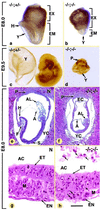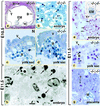Early embryonic lethality in PARP-1 Atm double-mutant mice suggests a functional synergy in cell proliferation during development
- PMID: 11238919
- PMCID: PMC86747
- DOI: 10.1128/MCB.21.5.1828-1832.2001
Early embryonic lethality in PARP-1 Atm double-mutant mice suggests a functional synergy in cell proliferation during development
Abstract
PARP-1 and ATM are both involved in the response to DNA strand breaks, resulting in induction of a signaling network responsible for DNA surveillance, cellular recovery, and cell survival. ATM interacts with double-strand break repair pathways and induces signals resulting in the control of the cell cycle-coupled checkpoints. PARP-1 acts as a DNA break sensor in the base excision repair pathway of DNA. Mice with mutations inactivating either protein show radiosensitivity and high radiation-induced chromosomal aberration frequencies. Embryos carrying double mutations of both PARP-1 and Atm genes were generated. These mutant embryos show apoptosis in the embryo but not in extraembryonic tissues and die at embryonic day 8.0, although extraembryonic tissues appear normal for up to 10.5 days of gestation. These results reveal a functional synergy between PARP-1 and ATM during a period of embryogenesis when cell cycle checkpoints are not active and the embryo is particularly sensitive to DNA damage. These results suggest that ATM and PARP-1 have synergistic phenotypes due to the effects of these proteins on signaling DNA damage and/or on distinct pathways of DNA repair.
Figures



References
-
- Ame J C, Rolli V, Schreiber V, Niedergang C, Apiou F, Decker P, Muller S, Hoger T, Menissier-de Murcia J, de Murcia G. PARP-2, a novel mammalian DNA damage-dependent poly(ADP-ribose) polymerase. J Biol Chem. 1999;274:17860–17868. - PubMed
-
- Barlow C, Hirotsune S, Paylor R, Liyanage M, Eckhaus M, Collins F, Shiloh Y, Crawley J N, Ried T, Tagle D, Wynshaw-Boris A. Atm-deficient mice: a paradigm of ataxia telangectasia. Cell. 1996;86:159–171. - PubMed
-
- Bishop A J, Barlow C, Wynshaw-Boris A J, Schiestl R H. Atm deficiency causes an increased frequency of intrachromosomal homologous recombination in mice. Cancer Res. 2000;60:395–399. - PubMed
-
- Cortez D, Wang Y, Qin J, Elledge S J. Requirement of ATM-dependent phosphorylation of brca1 in the DNA damage response to double-strand breaks. Science. 1999;286:1162–1166. - PubMed
Publication types
MeSH terms
Substances
LinkOut - more resources
Full Text Sources
Other Literature Sources
Molecular Biology Databases
Research Materials
Miscellaneous
